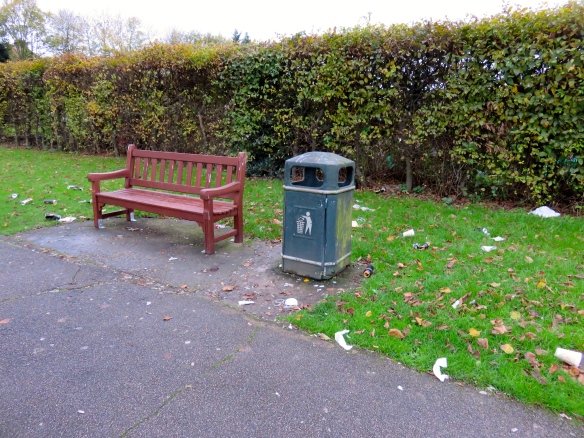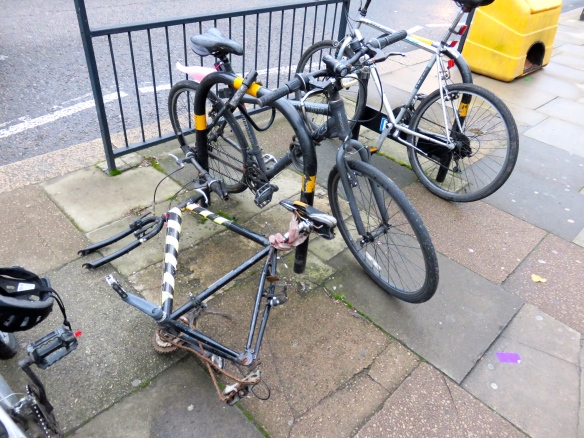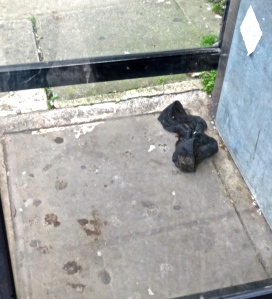Jackie, as usual, drove me to and from New Milton for my trip to London to visit Norman for lunch, and Carol afterwards. I took my usual routes from Waterloo to their respective homes.
A woman also being delivered to the home station this morning, left her driver with a farewell that had me chuckling. ‘What?’ she asked, addressing him through the still open passenger window……… Then ‘sod off’, followed by a cheery ‘see you later’. I hadn’t caught what had provoked the imprecation.
A short while later she and I had a good laugh about it on the crowded platform.
It was a gloomy day in London, which is probably why I focussed on some of the more seamy aspects of the capital’s suburbs. Littered around a bench in the recreation  ground at the far end of Preston Waye (sic) were beer cans, fag ends, and other debris from a party, the attenders of which had eschewed the bin provided. The bicycle rack
ground at the far end of Preston Waye (sic) were beer cans, fag ends, and other debris from a party, the attenders of which had eschewed the bin provided. The bicycle rack 
 across the street from Preston Road tube station had not saved one owner from losing his wheels, and judging by the rusting condition of what was left of his transport he had decided to leave it where it was. Alongside this a pair of soiled underpants or panties lay on the floor of a telephone box. I didn’t investigate them closely enough to determine the gender of their erstwhile wearer.
across the street from Preston Road tube station had not saved one owner from losing his wheels, and judging by the rusting condition of what was left of his transport he had decided to leave it where it was. Alongside this a pair of soiled underpants or panties lay on the floor of a telephone box. I didn’t investigate them closely enough to determine the gender of their erstwhile wearer.
Signal failures between Eastleigh and Basingstoke extended my outward journey by forty minutes and caused chaos at the end of the day when two train-loads left the terminus on one service, resulting in large numbers of passengers standing or sitting on the floors of the aisles. Squeezing past the standers and stepping over prone people on the way to the loo was rather embarrassing, especially as it was impossible not to touch them, and absolutely necessary to be careful where you did.
Horace Walpole’s ‘The Castle of Otranto’ dubbed by Andrew Graham-Dixon and others the first Gothic novel is a short book. I read it on the train. Published in the 1760s, the first edition rapidly sold out and has been in print ever since.
Harking back to the Middle Ages, as Gothic does, the book had all the necessary ingredients for evoking a romantic image of that period. There is a feudal tyrant, knights on a mission, damsels in distress, forbidding weather conditions, and a gloomy castle complete with dungeons, empty corridors, and a hidden passageway. The well-constructed plot, in five chapters, follows the form of Greek Tragedy, and the author borrows from Shakespeare devices such as his clown characters.
Walpole’s story was perfectly timed to engage the enthusiasm of his times for such tales, and spawned many others, such as Matthew Lewis’s ‘The Monk’, with which I continued whiling away my extended train journey.
 My Folio Society edition of ‘The Castle of Otranto’ is illustrated by Charles Keeping, one of my all-time favourites. He has a distinctive style and remains faithful to the text, nicely capturing the required mood. Here we have Isabella, a young woman fleeing the tyrant Manfred. A gleam of light in the gloomy castle depths renders her visible and displays the frightening path with rippling pools she has to tread.
My Folio Society edition of ‘The Castle of Otranto’ is illustrated by Charles Keeping, one of my all-time favourites. He has a distinctive style and remains faithful to the text, nicely capturing the required mood. Here we have Isabella, a young woman fleeing the tyrant Manfred. A gleam of light in the gloomy castle depths renders her visible and displays the frightening path with rippling pools she has to tread.
The First Gothic Novel

This might the most perfect blog post ever. It is humane and funny and sincere. Thank you, Derrick.
Wow! Thank you Alex